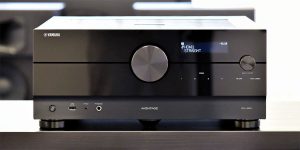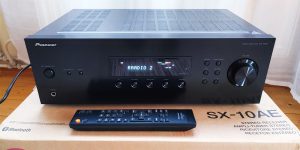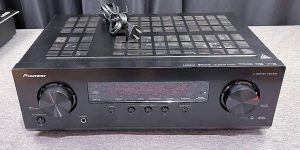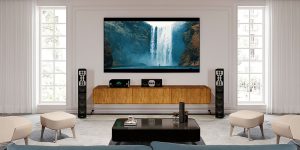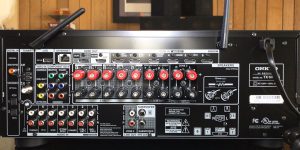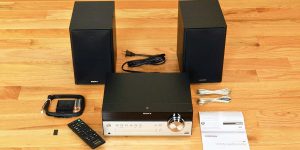Yes, a home theater is considered a luxury, and an AV receiver is the backbone of any system. Nevertheless, I have great news if you are ready for a new purchase! I have prepared a review of the best receivers under $1000, which will surprise you with their functionality and features. Modern devices of this type support high-resolution video, but the main thing is they can give you surround sound, immersing the viewer in the events on the screen, regardless of whether you’re watching a movie or sports program. You can feel at the center of the action without spending your last savings.
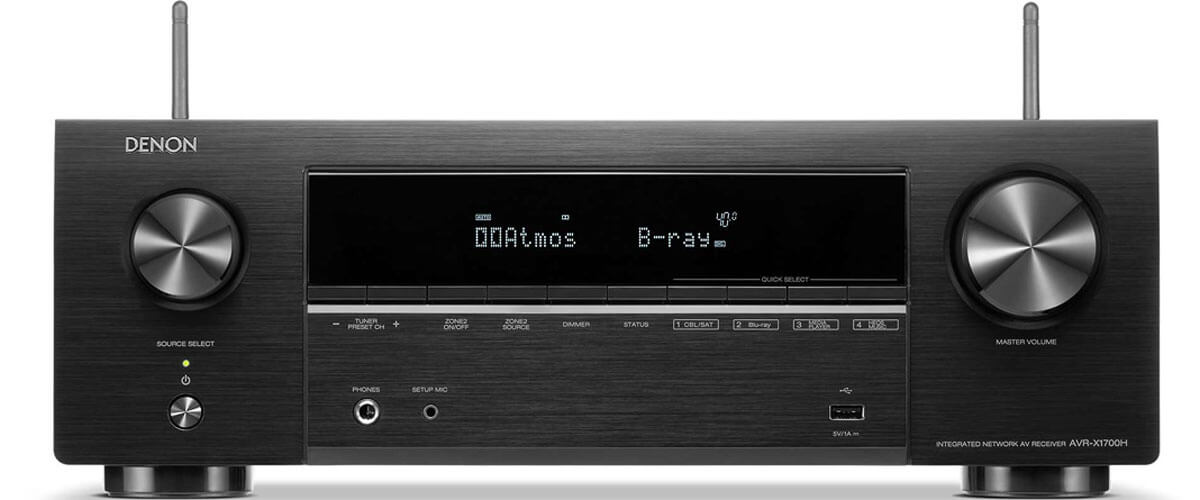
AV receiver under $1000 comparison table
| Name | Channels | Power output | HDMI in/out | Bluetooth/Wi-Fi | Review |
|---|---|---|---|---|---|
| Denon AVR-X1700H best overall | 7.2 | 80W/8 Ohm, 120W/6 Ohm | 6/1 | yes/yes | Review |
| Marantz NR1510 also great | 5.2 | 50W/8 Ohm, 60W/6 Ohm | 6/1 | yes/yes | Review |
| Yamaha RX-A2A | 7.2 | 80W/8 Ohm | 7/1 | yes/yes | Review |
What receivers under 1000 bucks did we test?
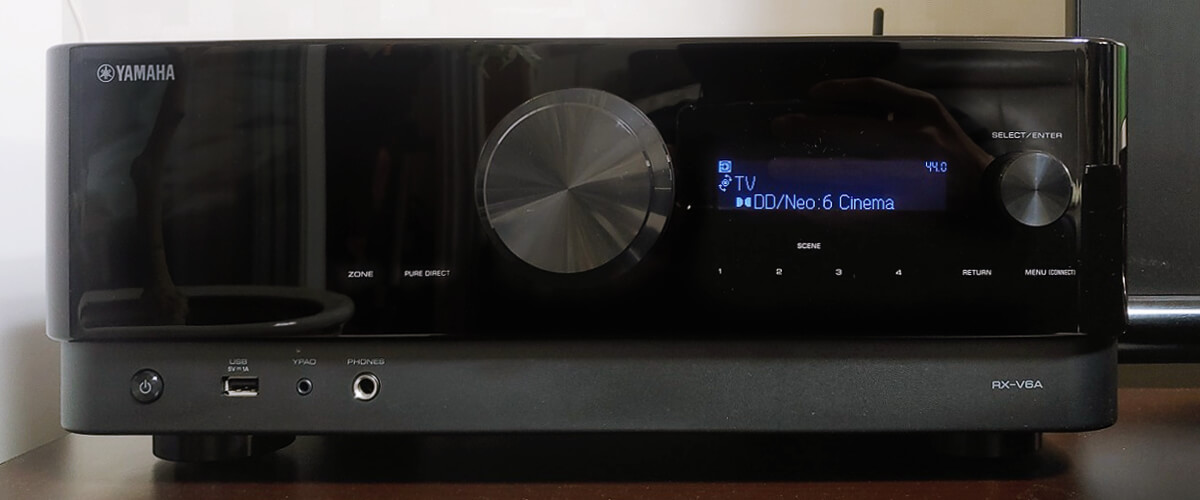
When developing the ranking of the best receivers under $1000, in addition to personal impressions from testing, I also studied customer reviews from various shopping sites and the opinion of other users and experts from popular audio forums. Based on all of this, weighing all the pros and cons, I have compiled my list relevant for 2024.
Also, in addition to the models on my chart, I tested many current models on the market. And it’s worth noting that for a combination of technical reasons and testing impressions, the top did not include such models as:
- Yamaha RX-V6A.
- Marantz SR5015.
- Denon AVR-S970H.
Our criteria for choosing the best receiver under $1000
The criteria by which I determined my choice were the following factors: compliance with the $1000 budget, listening experience, availability of necessary built-in features (support for modern video technologies, surround sound formats, Bluetooth, Ethernet/Wi-Fi/streaming services, etc.), a sufficient number of inputs and outputs.
A detailed description of each can be found in our section – Factors to consider when buying an AVR under $1000.
Best AV receiver under $1000 reviews
Denon AVR-X1700H – best overall

First on my list is the Denon AVR-X1700H, released in 2021. This receiver has the functionality usually offered by more expensive models (by the way, it is the one with the lowest price on my list).
So, its HDMI connections, which have 6/1 (HDCP2.3, CEC, eARC), are designed for viewing Dolby Vision and HDR10+ videos at 8K/60Hz and 4K/120Hz. You also get multiple inputs for older equipment and a phono input for the turntable. You can also plug in a second subwoofer for better bass distribution, but that’s about every model in my review. Wireless Wi-Fi and Bluetooth connectivity and built-in HEOS are what you need for content from streaming services (including working with Roon Tested). The apps, however, assume you’ll be using the HEOS app on your smartphone (the receiver is compatible with Android and iOS). This reduces the quality of the music somewhat, but I would like to point out that the signal was never lost, and the pairing was instantaneous. I bring this to your attention, as more expensive models in my chart have seen such problems.
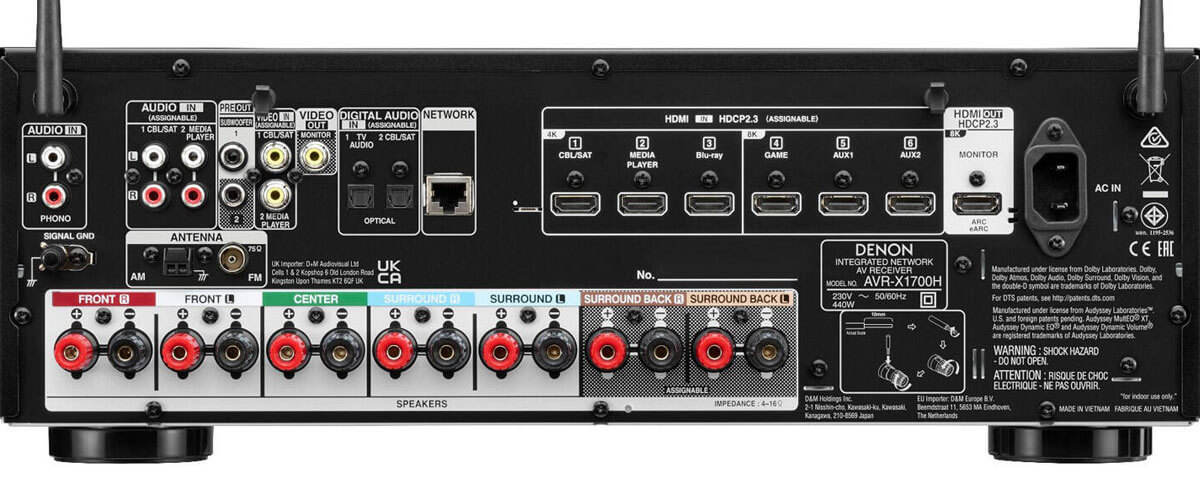
The AVR-X1700H is pretty powerful for its category but not the rating leader on this aspect of 80W (8 Ohm, 20 Hz – 20 kHz, 0.08% 2ch Drive). Although, frankly, in my experience with inexpensive devices, you can’t crank the volume up without getting interference and distortion. The audio can also be broadcast to 2 Zones, but you’ll have to tinker with the setup. No, I have no complaints about AudysseyMultEQ XT. This calibration system is much nicer than many others, but you don’t get detailed setup instructions and must study the information on the Denon website. But it’s worth it. By spending a little more time on the setup, you’ll get the great famous warm sound of the AVR-X1700H.
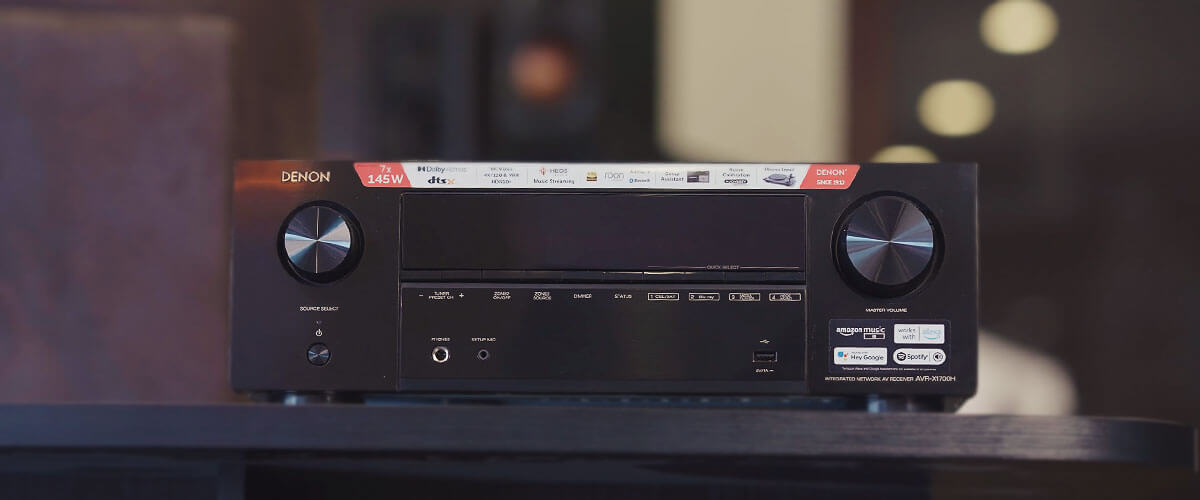
This baby supports Dolby Atmos and DTS:X surround sound formats. But I also like the support for Dolby Atmos Height Virtualization and DTS Virtual:X. I think it’s important to be able not to chisel your ceiling to enjoy the 3D sound. Not all receivers in this category have this option; you just have to give up the top sound channels.
I can’t say that it doesn’t have disadvantages. For example, it takes a long time (20-30 seconds) to connect, and sometimes the video hangs. But I think the receiver is just wonderful in its price category, and compromises are inevitable here.
The Denon AVR-X1700H combines great sound and good build quality, features typically found in more expensive models, a modestly pleasant price, and sane compromises. As a result, this is the best AV receiver for under $1000 for modern users who are used to running their lives with smartphones.
Key specs
- Channels: 7.2.
- Power output: 80W/8 Ohm, 120W/6 Ohm.
- HDMI inputs/outputs: 6/1.
- Video functions: 8K/60Hz, 4K/120Hz pass-though, upscaling up to 8K.
- Bluetooth/Wi-Fi: yes/yes.
- Streaming services: AirPlay 2, Spotify, TuneIn, Deezer, Tidal, Netflix, Amazon Prime.
- Supports: HDMI ARC, HDMI eARC, HDMI CEC, HDCP2.3, HDR10+, Dolby Vision.
- Surround sound: DTS:X, DTS Virtual:X, Dolby Atmos, DTS HD Master, Dolby TrueHD.
Pros
- The wireless signal does not drop, and pairing is instantaneous.
- Supports Dolby Atmos Height Virtualization and DTS Virtual:X, which is a bonus over some other models.
Cons
- Doesn’t have a detailed manual, which makes setup difficult.
- Rare video hang-ups have been noticed.
Marantz NR1510 – also great
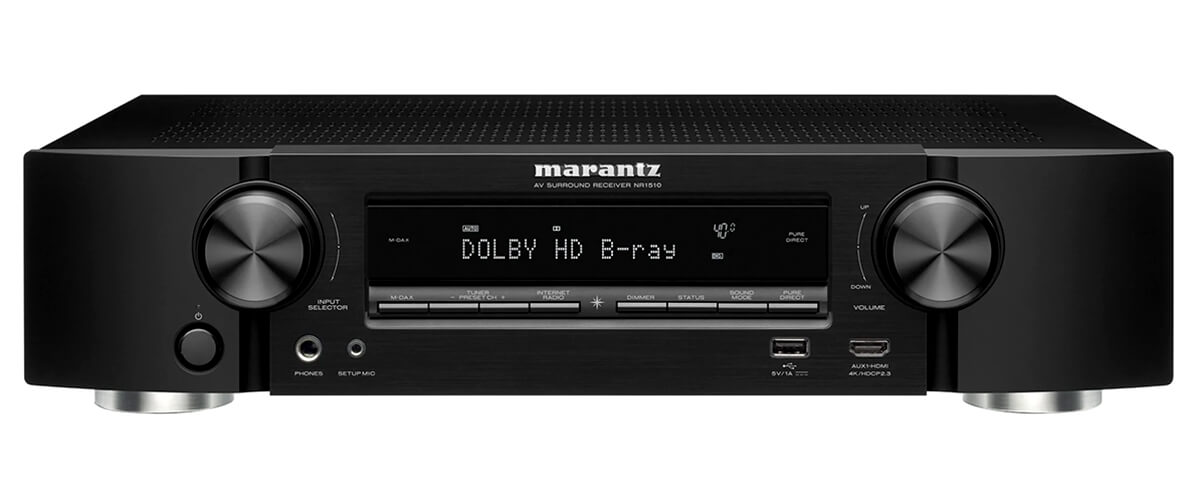
Since 2001, Marantz and Denon have formed a single holding company that produces similar products for both brands. Accordingly, a quick glance at the Marantz NR1510 surround sound receiver, a 2019 model, might make you think that the receiver loses on all fronts to the Denon AVR-X1700H but costs a bit more. How so? It’s all about the fact that with Marantz, we’re always talking about more expensive internal components, which means you get more reliability and better sound quality. Whether this is worth the sacrifice in functionality is up to you to decide.
The NR1510 has fewer HDMI inputs, namely 5 (HDCP2.3) and one (eARC) output. As a result, it has access to HDR, HLG, and Dolby Vision video content at 4K/60Hz, but no 8K like Denon. But the 3D Signal Pass-Through option is available.
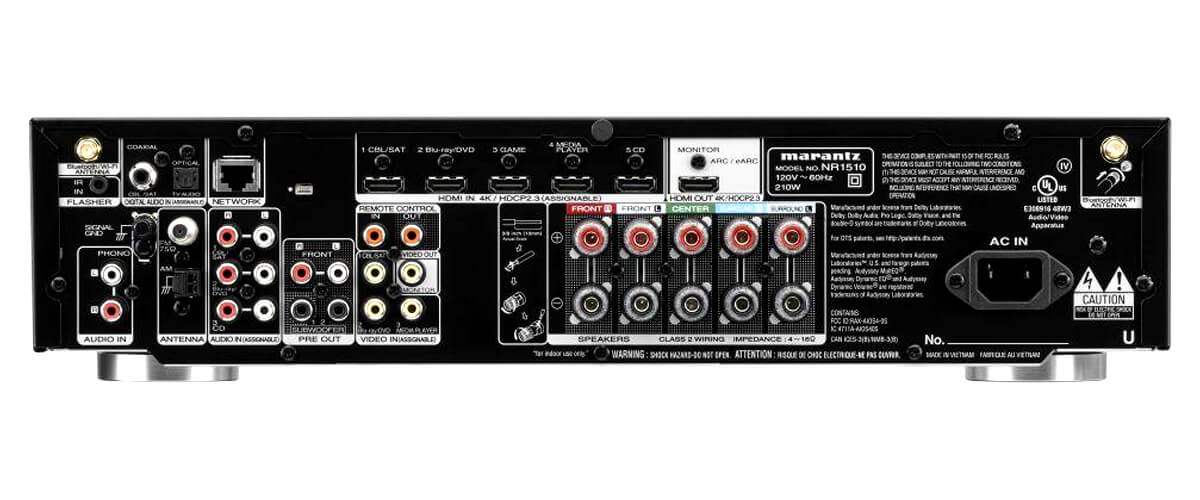
Wi-Fi and Bluetooth support AirPlay 2 Audio Streaming and TuneIn, as well as popular streaming services. But I did notice that while the streaming doesn’t drop, the sound on Bluetooth isn’t clear. I really liked the M-DAX feature, though. Using it when listening to old music (the 60’s), I got an authentic sound, improved over the original format. The technology at the time just didn’t allow for a clean recording, but the quality was an order of magnitude better.
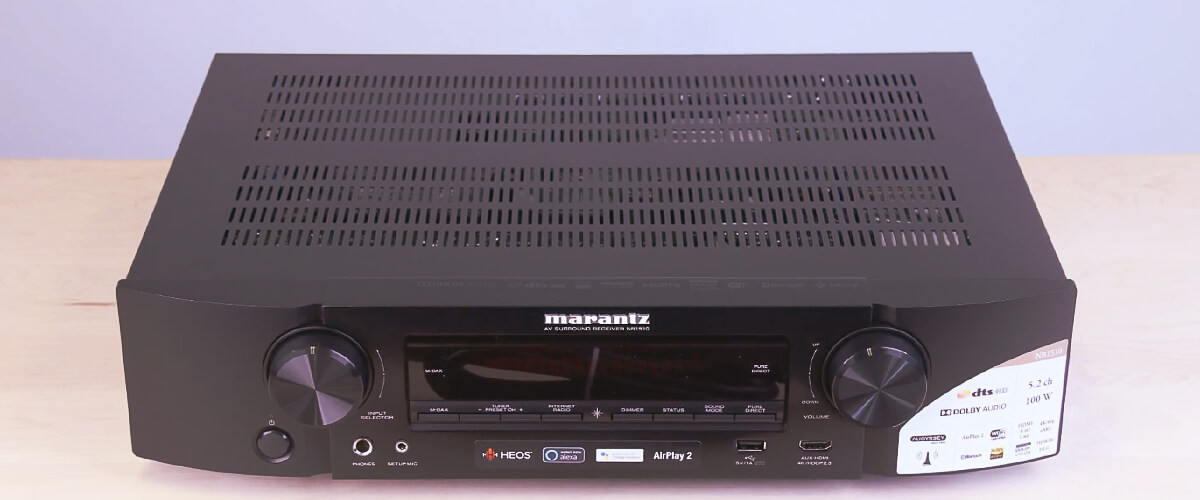
The Marantz is less powerful than the Denon and offers only 50 watts (8 Ohms, 20 Hz – 20 kHz, 0.08% 2ch Drive). It is also inferior in the area of surround sound. The NR1510 is 5.2 channelized, so there’s no Atmos to speak of, and the AVR only offers DTS HD Master support. And there is no Multi-Room feature, though the built-in HEOS somewhat compensates for its absence. But the sound quality is worthy of all praise (discounting the receiver category). The fact is that even with the usual speakers, the Marantz improves the overall soundstage. The center channel is much louder, and the bass is flatter when I watch movies or shows. You don’t have to regret the low power; you don’t have to turn up the volume to hear the dialogues. Decent compensation for basic simplicity because it doesn’t work that way with most of the models in my review.
The receiver offers better sound than many models in its category and, at the same time, can improve the sound quality even with your old equipment. As a result, the Marantz NR1510 is the best home theater receiver under 1000 for those who prefer sound over functionality.
Key specs
- Channels: 5.2.
- Power output: 50W/8 Ohm, 60W/6 Ohm.
- HDMI inputs/outputs: 6/1.
- Video functions: 4K/60Hz pass-through.
- Bluetooth/Wi-Fi: yes/yes.
- Streaming services: AirPlay2, Deezer, Tidal, Pandora, SiriusXM, Napster, SoundCloud, Amazon Music, Amazon Music HD, Mood mix.
- Supports: HDMI ARC, eARC, HLG, HDCP2.3, HDR10, Dolby Vision.
- Surround sound: DTS HD Master.
Pros
- The M-DAX feature works well, enhancing the quality of older recordings.
- Even with familiar speakers, Marantz has improved the overall soundstage.
- You don’t have to turn up the volume to hear the dialogue.
Cons
- Lowest power compared to other models (50W).
- The sound over Bluetooth is not clear.
Yamaha RX-A2A
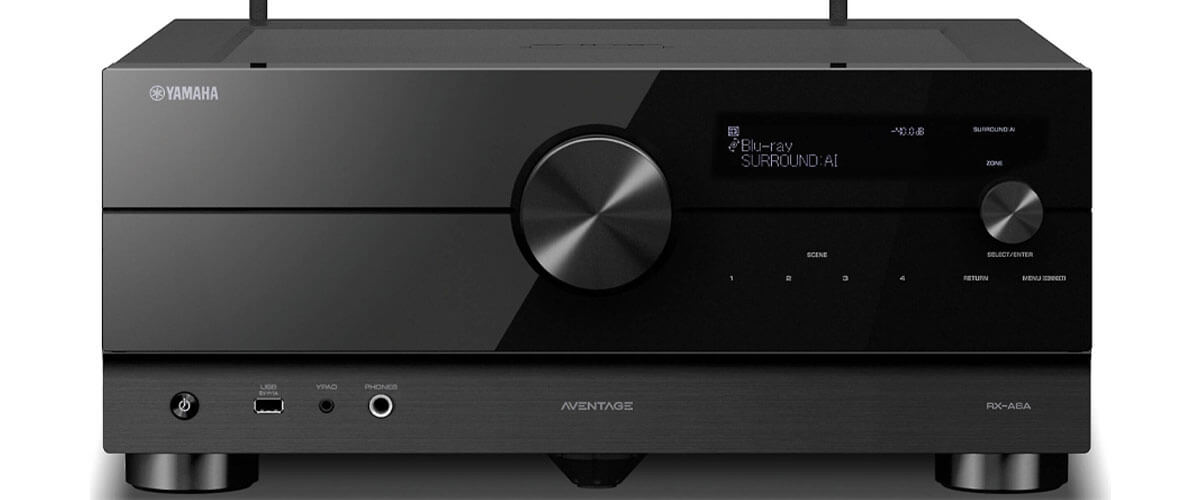
The next receiver in the ranking is almost identical to the Denon AVR-X1700H in functionality (especially in the video area). The Yamaha RX-A2A was released in 2020, and it offers 100 watts (8 ohms, 20Hz – 20kHz, 0.06%, 2ch). But I noted right away that the AVR never overheated during operation. This is important because most devices suffer from this and need extra ventilation.
The wireless connection is also similar to Denon. The only difference is that Yamaha has its own MusicCast ecosystem, hugely popular with fans for its user-friendly interface and stable performance. Much better than some other ecosystems. Plus, I never once encountered any outages, which is often the case with other options.
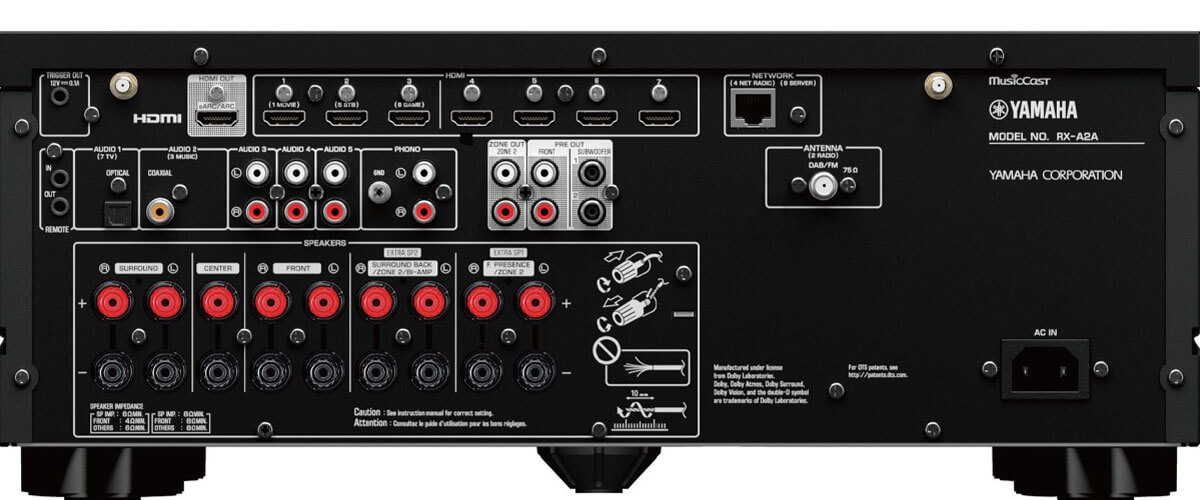
But since the Yamaha RX-A2A is more expensive than the Denon, you might rightly ask what its great lits are. Mostly, it concerns the brand’s surround sound technology for its products. The receiver is equipped with CINEMA DSP 3D, with which watching movies, sports, and games creates a concert sound experience. And Compressed Music Enhancer is capable of improving the quality of the compressed sound to the original.
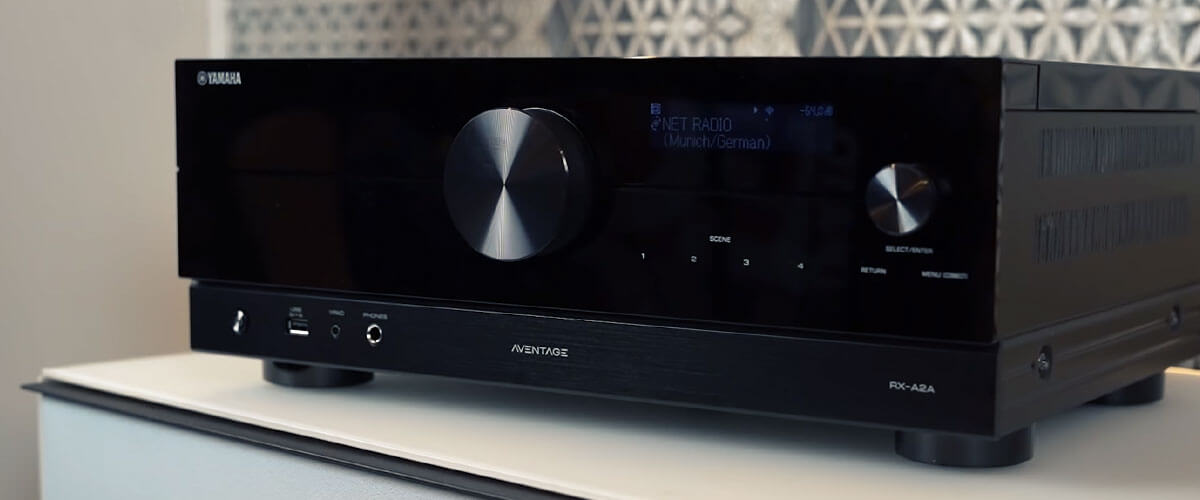
Yamaha is known for its uniquely cool transparent clear sound. Indeed, the sword battle scenes in The Messenger: The Story of Joan of Arc sounded terrific, making me duck at some points or even close one eye (I was still trying to follow the action with the other). But a couple of times, I noticed some slight lag in the sound from the picture. I was also a little annoyed by the slow OSD. But maybe I’m just spoiled by more expensive models.
The Yamaha RX-A2A is a great receiver in its category, offering unique technology for surround sound and beautiful clear sound. It is a top choice, confirmed by a huge army of fans.
Key specs
- Channels: 7.2.
- Power output: 80W/8 Ohm.
- HDMI inputs/outputs: 7/1.
- Video functions: 8K/60Hz, 4K/120Hz, upscaling up to 4K.
- Bluetooth/Wi-Fi: yes/yes.
- Streaming services: AirPlay 2, Spotify, TuneIn, Deezer, Tidal, Netflix, Amazon Prime.
- Supports: HDMI ARC, HDMI eARC, HDMI CEC, HDCP2.3, HDR10+, Dolby Vision.
- Surround sound: DTS:X, DTS Virtual:X, Dolby Atmos, DTS HD Master, Dolby TrueHD.
Pros
- Does not overheat during operation.
- Great friendly MusicCast menu and smooth operation.
- Unique CINEMA DSP 3D technology gives you concert sound right in your room.
Cons
- Very rarely, but I have noticed a lag in the sound from the picture.
- The on-screen menu is slow.
Sony STR-AN1000
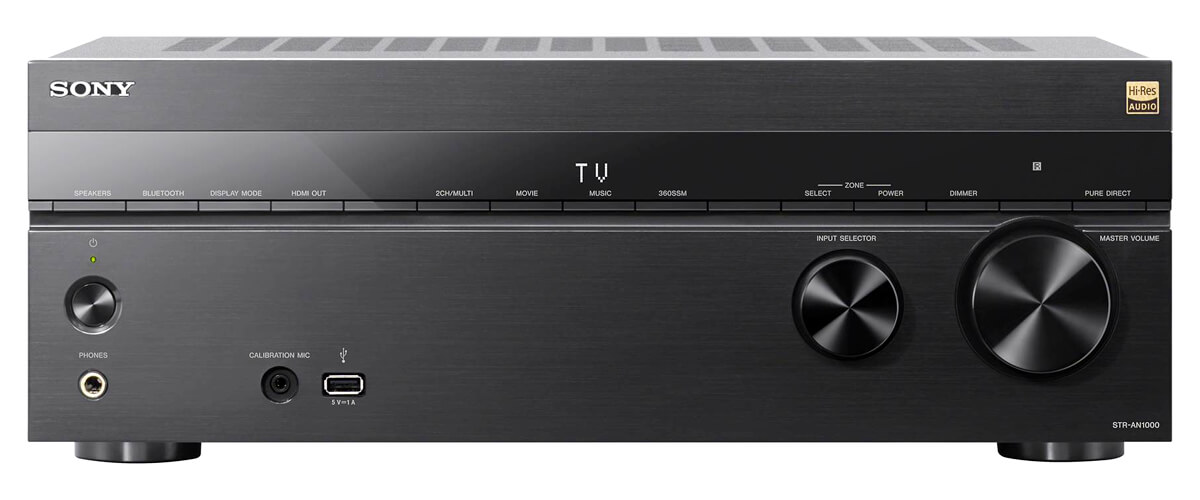
This is a newcomer among the presented models, released in 2023. So, against the background of the general similarity between Denon and Yamaha, it still has some modern features worth noting.
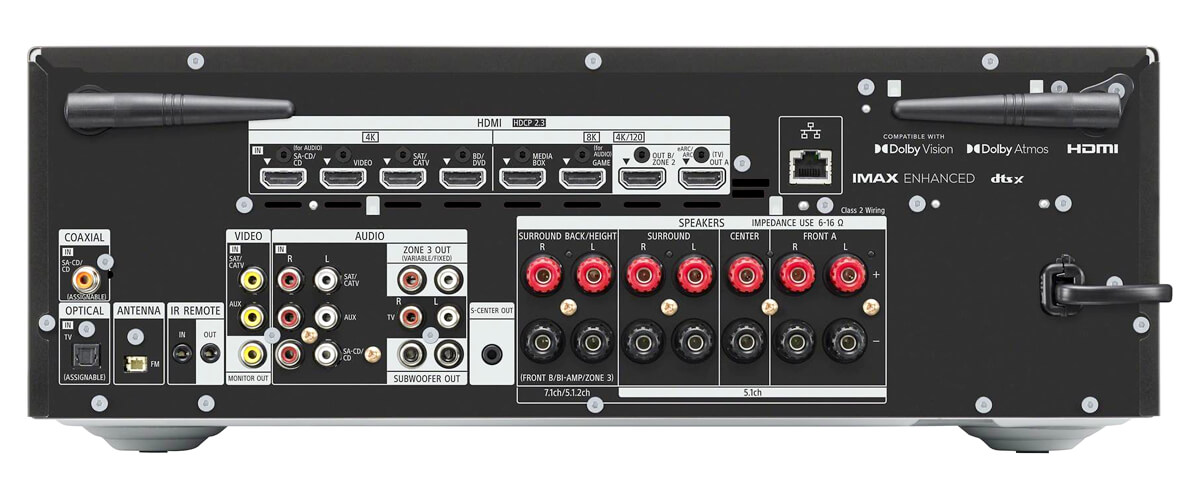
But first, let’s go over the general data. The power of the receiver, declared by the manufacturer, is 165W (6 Ohm, 1 kHz, 0.9%, 1ch). From the video, we have the same, plus IMAX Enhanced. And for surround sound, it also supports audio virtualization for Dolby Atmos and DTS:X (like Denon). The wireless connection is compatible with the streaming sites, too. I wouldn’t say I liked the way Bluetooth works, though. You can’t adjust audio and video over it, so there is a slight audio delay while using Bluetooth headphones or Bluetooth speakers. Unfortunately, the manual has no suggestions on how to solve this problem. In the heyday of wireless technology, I think this is unacceptable.
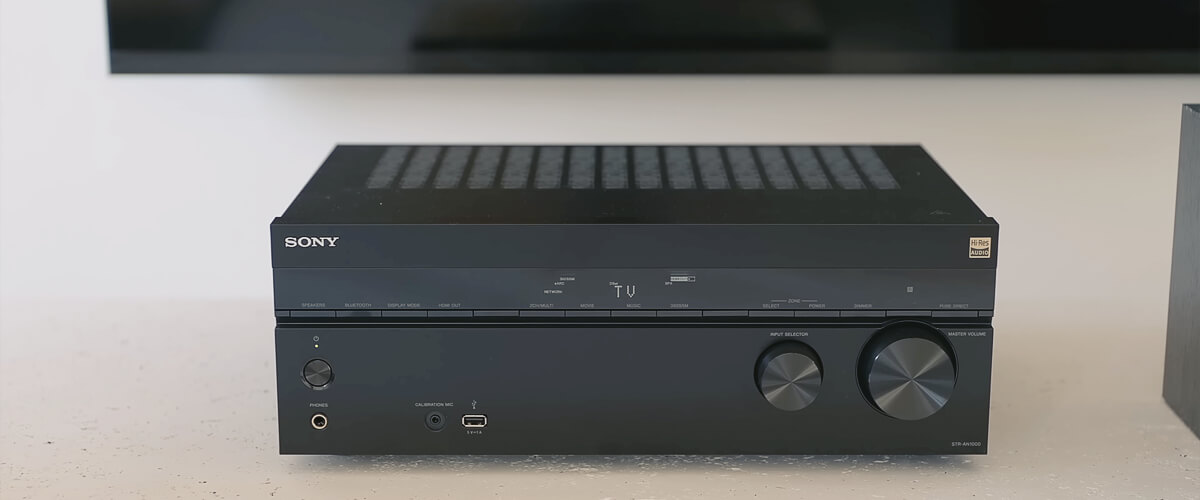
But three things are worth separate digressions:
Digital Cinema Auto Calibration IX is something. It beats no comparison to AccuEQ in offering great adaptation. Plus, you can adjust the channels manually if you’re too picky.
Center Speaker Lift is a bit of a strange experience at first, but it ends up having an incredible effect: it really moves the sound up, so it feels like the dialog is coming right out of the TV.
360 Spatial Sound Mapping makes some audio tracks sound bigger and more expensive than other systems.
The Sony STR-AN1000 is designed for people who want to take full advantage of surround sound. Thanks to the innovations with which this receiver is equipped, you will take your home theater system to the next level.
Key specs
- Channels: 7.2.
- Power output: 165W/6 Ohms.
- HDMI inputs/outputs: 6/2.
- Video functions: 8K/60Hz, 4K/120Hz, upscaling up to 4K.
- Bluetooth/Wi-Fi: yes/yes.
- Streaming services: AirPlay 2, Spotify, TuneIn, Deezer, Tidal, Netflix, Amazon Prime.
- Supports: HDMI ARC, HDMI eARC, HDCP2.2, HLG, HDR10, HDR10+, Dynamic HDR, Dolby Vision.
- Surround sound: DTS HD Master, DTS:X, DTS Virtual:X, Dolby TrueHD, Dolby Atmos Height Virtualizer, Dolby Atmos, Dolby Surround, IMAX Enhanced.
Pros
- Perfect Digital Cinema Auto Calibration IX.
- Center Speaker Lift moves the sound up so that dialog feels like it’s coming from your television.
- With 360 Spatial Sound Mapping, some audio tracks sound bigger and more expansive than with other systems.
Cons
- Bluetooth headphones or Bluetooth speakers work with a slight sound delay.
Pioneer Elite VSX-LX105
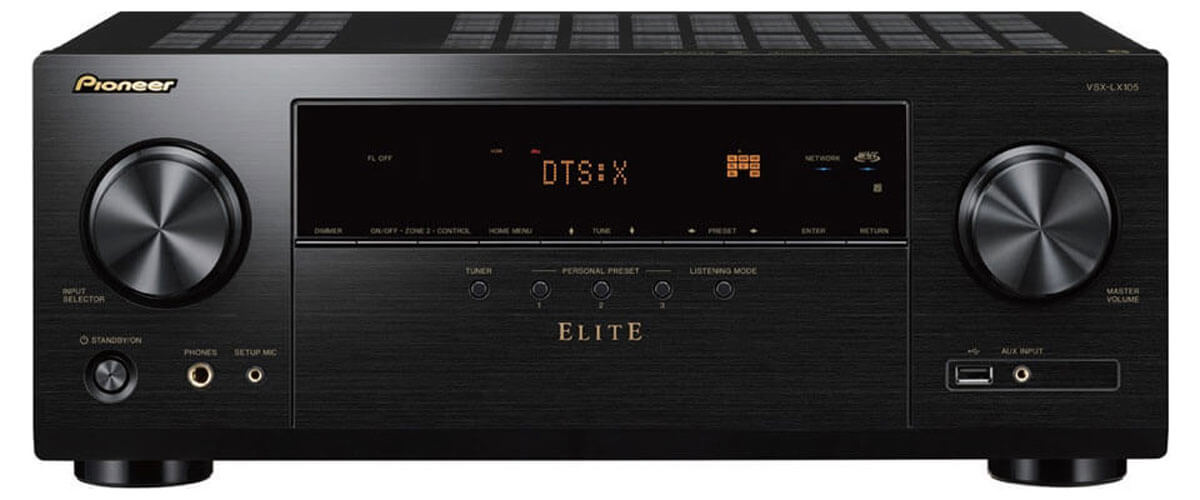
My rating could not do without the representative of Pioneer. Pioneer Elite VSX-LX105 2021 model is quite worthy of being among the presented models because, in its functions and sound quality, it corresponds to the declared category to the full extent.
I would say that it is a fair middle ground among all the models presented here. The Pioneer Elite VSX-LX105 offers 8K video, HDR10+, and Dolby Vision formats, as well as surround sound formats and their virtualization. There are no differences in the number of wired and wireless connections either, but the quality is worth discussing.
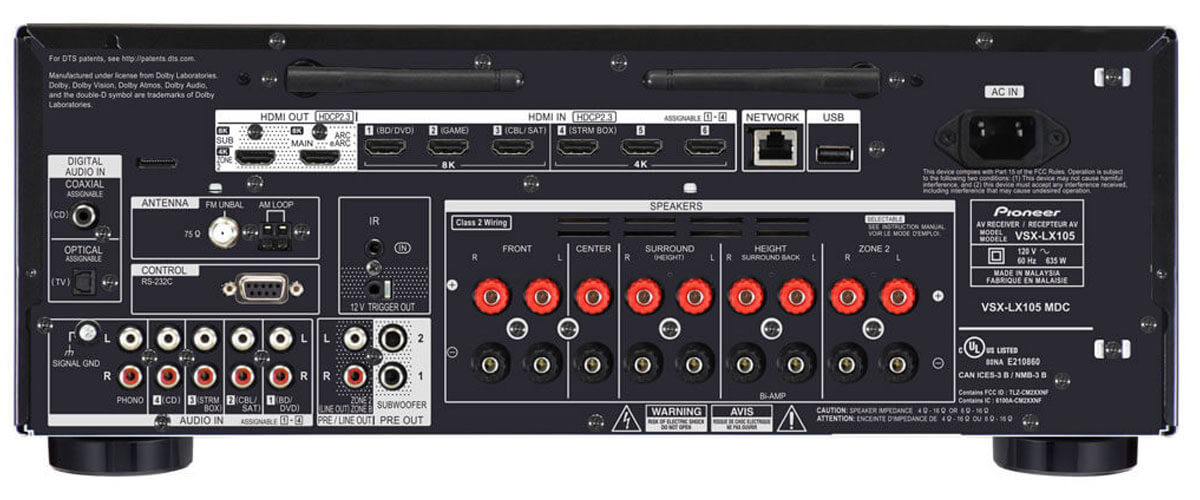
The fact is that Pioneer has equipped its receiver with improved versions of both Bluetooth and Wi-Fi. In fact, DTS Play-Fi works flawlessly with Chromecast and Sonos (you have to buy a separate port). But streaming services streamed via bi-directional Bluetooth, which uses SBC, aptX, or aptX HD codecs, sound completely unconvincing. The sound from Spotify or Apple was flat, unemotional, and greatly frustrated me.
I really liked the Pioneer Remote App for iOS (it also works for Android), which controls all aspects of the Elite VSX-LX105. Sometimes you don’t even have to turn on the monitor to control it. It’s very convenient. The remote is also good, and it’s better to use it in conjunction with the app because some functions are only available with the remote, and some are only available through the phone app.
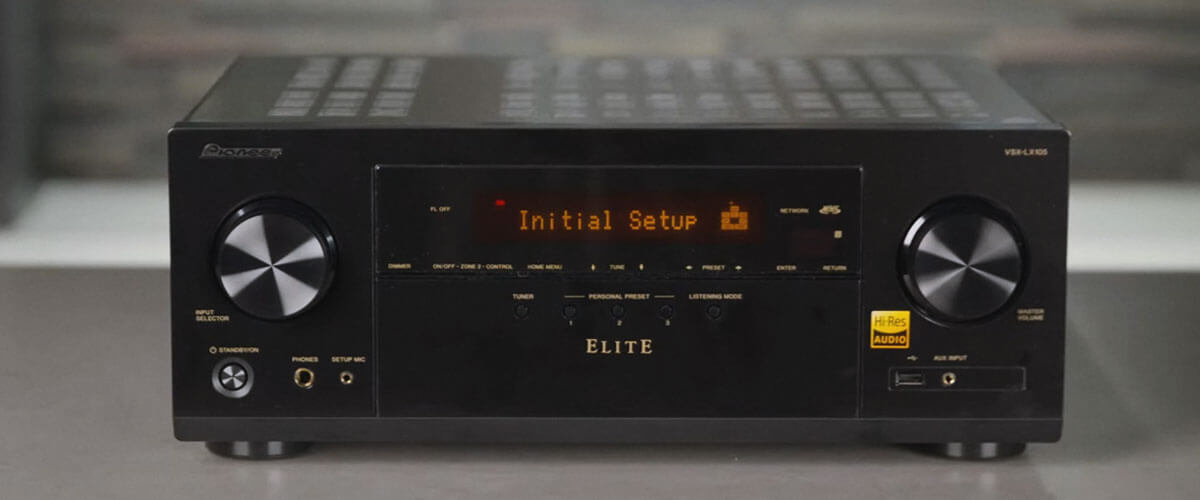
As for surround sound – everything works well, worthy of the title of “golden mean” in its category. The overall soundstage is quite detailed and enveloping and fills the space well. However, you can’t adjust the crossover frequencies for each speaker, which other models have. Which means you can’t optimize the sound for your needs. But with this AVR, you can watch old movies with a monaural soundtrack. The center channel eliminates the problems and distortion caused by playing a mono recording through a pair of speakers. Most receivers don’t have this feature. But to use it, you must select it manually in the settings.
The Pioneer Elite VSX-LX105 is an excellent mid-range receiver for users who prefer to watch old and new movies. While it has no outstanding options, it is nevertheless a reliable horse. It is a decent AVR under $1000.
Key specs
- Channels: 9.2.
- Power output: 100W/8 Ohm, 210W/6 Ohm.
- HDMI inputs/outputs: 6/2.
- Video functions: 8K/60Hz, 4K/120Hz, upscaling up to 8K.
- Bluetooth/Wi-Fi: yes/yes.
- Streaming services: AirPlay 2, Spotify, TuneIn, Deezer, Tidal, Netflix, Amazon Prime.
- Supports: HDMI ARC, HDMI eARC, HDMI CEC, HDCP2.3, HDR10, HDR10+, Dolby Vision.
- Surround sound: DTS HD Master, DTS Neural:X, Dolby TrueHD, Dolby Surround, Dolby Digital Plus, Dolby Atmos Height Virtualization, Dolby Atmos.
Pros
- The Pioneer Remote App for smartphone control is very handy and works for iOS and Android. Sometimes you don’t even need to turn on the monitor.
- The center channel eliminates the problems and distortion caused by playing a mono recording through a pair of speakers.
Cons
- You can’t adjust the crossover frequencies for each speaker.
- Pioneer sounds muddy when streaming music from Spotify or Apple.
Factors to consider when buying an AVR under $1000
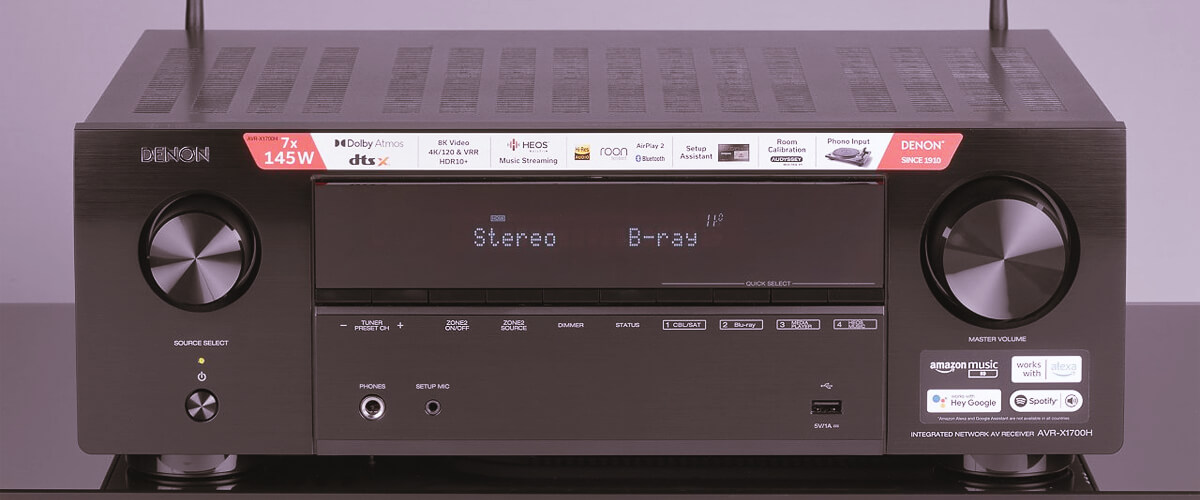
If you are afraid to choose and buy an AVR, don’t be. I offer you a few key aspects to consider before considering your options. Once you have defined these, the range of choices will be much smaller, and you will easily narrow your search. Good luck!
Power and wattage
Power matters in the sense that you hear enough but do not drown in a mishmash of sound. Smooth sound distribution depends on the size of your room, and the category of receivers I reviewed in this article offers power in the 50 to 100W range. These settings are good for rooms between 150 and 300 ft². Also, pay attention to the capabilities of your speakers. A mismatch in parameters can cause them to break down.
Number of channels and surround sound formats
Amplification channels are paramount if you want to enjoy modern surround sound formats. For example, the simplest 5.1 configurations will give you a sense of presence, but you won’t be able to experience the delights of Dolby Atmos. A 7.1 configuration adds overhead channels that let you feel the effect of helicopters flying overhead, enhancing the immersive effect. Then there’s more. And so on, all the way up to 13 channels. But in the receivers under the $1,000 category, you can only find 7 channels at most, which can broadcast Dolby Atmos and DTS:X content. For those who don’t want to install speakers in the ceiling, you should look for virtual surround sound formats.
Connectivity options and Video features
When paying attention to connections, you must consider all the equipment you want to connect to the system. The main ones today are HDMI inputs and outputs. Better if they are equipped with HDCP 2.3, CEC, ARC, and eARC. This will improve signal quality. Plus, it will determine what kind of content you can watch. Older models support 4K/60Hz; newer models already have 4K/120Hz. The most advanced ones are 8K, although you’ll need a TV that supports that resolution. The most common content formats on today’s platforms are HDR10 and Dolby Vision.
If you have older equipment, you will need coaxial and optical connectors. In addition, Bluetooth and Wi-Fi wireless capabilities will allow you to listen to content from devices and streaming services.
Ease of use
AV receivers are not always easy to set up and use. That’s why I recommend selecting devices according to your level so that you don’t start getting nervous while you’re plugging in a movie. In this matter, it is worth paying attention to the smart screen display, remote control, and the ability to install smartphone apps. They can make a big difference.
We are supported by our audience. When you purchase through links on our site, we may earn an affiliate commission at no extra cost to you.
Our newsletter
* We will never send you spam or share your email with third parties

![Best Budget Receivers [Reviewed and Tested]](https://thetechholics.com/wp-content/uploads/2023/10/best-budget-av-receiver-300x150.jpg)
![Best 9-Channels AV Receivers [Reviewed and Tested]](https://thetechholics.com/wp-content/uploads/2023/10/best-9-2-receiver-300x150.jpg)

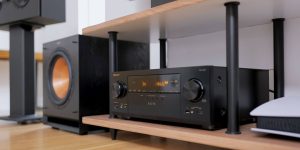
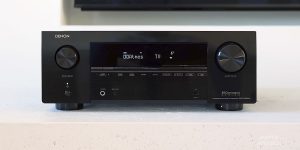
![Pioneer vs Denon Receivers [Top Models Compared and Tested]](https://thetechholics.com/wp-content/uploads/2023/10/denon-vs-pioneer-review-300x150.jpg)
